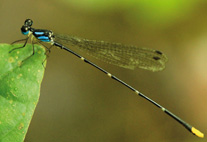Abstract
A new genus, Diacanthomyia gen. nov. assigned to the subtribe Thyreophorina of the family Piophilidae is described based on a new species, Diacanthomyia okidoi sp. nov. recently found in Honshu and Kyushu, Japan. The new genus is somewhat similar to the European Centrophlebomyia of the subtribe. However, the new genus is distinguished from the known genera of the subtribe by the following combination of characters: body extensively pollinose or pruinose, 2 pairs of strong reclinate fronto-orbital bristles, 1–2 strong subvibrissal bristles in addition to 2 strong vibrissae, prosternum setose, 1 presutural dorsocentral, 1 strong anterior postsutural intra-alar, scutellum with 2 pairs of scutellar bristles without additional setulae, extensively microtrichose wing membrane, a dark round spot at r-m crossvein and a dark stripe covering m-m crossvein, and vein CuA+CuP abruptly terminated distant from wing margin. The type species inhabits evergreen broadleaved and deciduous broadleaved forests and adults appear during the cold season from December to March. Adults are attracted to decaying carcasses of Japanese deer and wild boar and traps baited with decaying pork spareribs and chicken meat with bones. The larvae of this species feed on decaying meat and marrow of deer, take less than 2 months to grow to mature larvae, and enter into diapause in the soil until autumn.

